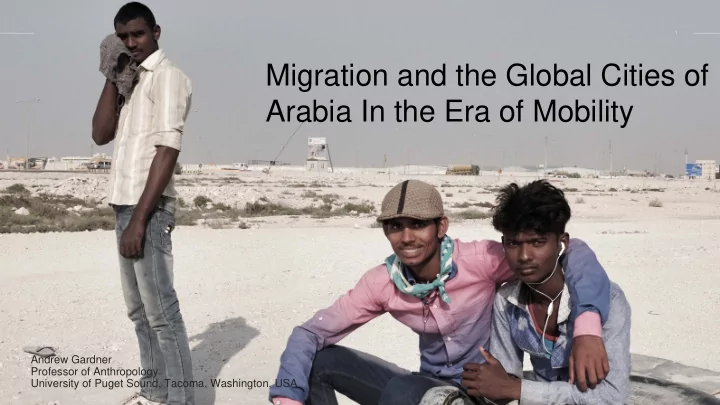

1 Migration and the Global Cities of Arabia In the Era of Mobility Andrew Gardner Professor of Anthropology University of Puget Sound, Tacoma, Washington, USA
2 MIGRATION AND THE GLOBAL CITIES OF ARABIA ■ Third largest global flow of transnational migration Third Largest ■ My understanding: via a multi-sited ethnographic approach attentive to Destination both ends of these migration conduits
3 MIGRATION AND THE GLOBAL CITIES OF ARABIA 8 pt The Geography of Gulf • This migration system is centered on the Indian Ocean World Migration • The geography of in-migration therein is constantly evolving and shifting
4 MIGRATION AND THE GLOBAL CITIES OF ARABIA Non-Nationals in the GCC 10,067,839 7,316,073 2,978,024 2,161,757 2,006,569 683,818 Bahrain Kuwait Oman Qatar Saudi Arabia UAE • Non-nationals includes migrants, refugees, The Scale of Gulf stateless persons Migration • The total stock of migrants: 25,214,080 • No pathway to citizenship or naturalization Data from the GLMM (2016)
5 MIGRATION AND THE GLOBAL CITIES OF ARABIA The Kafala and Variability ■ Based on a set of practices distilled in the early and mid-twentieth century, migration is organized and governed by the kafala , or sponsorship system. ■ Via the kafala , migrants must obtain employment prior to arrival, and are tied to that employer for the duration of their stay abroad. That stay is usually organized by two-year contracts. ■ The resulting unfree labor market constructs the variability characteristic of migrant experiences in Arabia. ■ Throughout the GCC, we are witnessing the continued erosion of these arrangements and practices, for the better in my (and others’) estimation.
6 MIGRATION AND THE GLOBAL CITIES OF ARABIA The Migration Industry ■ Dalals and informal brokers in villages ■ Labor brokers and recruitment agents in urban hubs ■ A constellation of related businesses flourish alongside ■ Manpower agencies, human resources personnel, and many others in receiving countries ■ Entire economies? Airlines? Police? Expansive thinking about the “migration industry” possible here …
7 MIGRATION AND THE GLOBAL CITIES OF ARABIA 100 37 75 46 53 70 86 89 50 63 25 54 47 30 14 0 11 Saudi Arabia Oman Bahrain Kuwait Qatar UAE Nationals Non-Nationals • Unprecedented proportions of foreign residents and citizens Proportions, Hierarchy and Difference occupy these cities and states • As an anthropologist, I want to convey how I think about this in terms of indignenousness and the preservation of culture amidst the swell of interconnection and globalization.
8 MIGRATION AND THE GLOBAL CITIES OF ARABIA Segregation, Enclaving and Spatialization ■ Transnational labor migrants in Arabia generally live a segregated life in the city ■ They are sifted and sorted from various front-stage public spaces in the city ■ Their dwellings — typically labor camps arranged by their employers — are frequently located in peripheral zones, districts, and other sorts of places that have been long referred to as “bachelor cities” ■ They are transported to and from these peripheral enclaves in busses or transportation arranged by their employers.
9 MIGRATION AND THE GLOBAL CITIES OF ARABIA Critique Behind Walls ■ I first began writing about these labor migrants’ segregation when I lived in Qatar, in the compound pictured here. ■ Compounds are groups of a hundred or so flats and villas, typically provided by employers to middle class migrants, or “expats” of a professional nature. ■ The walls enclose — or segregate — other sorts of foreigners from the public spaces of the city. ■ Note the irony here. It was this irony that sparked my thinking about migrants and their place in the Arabian city
10 MIGRATION AND THE GLOBAL CITIES OF ARABIA Space and Exception ■ Beginning with this realization about how segregation in space transcended migrant class, I began to see other parallels in urban space ■ Internet censorship, alcohol, gender-mixed campuses, property ownership, and more … ■ In my forthcoming book, I trace this spatialization of foreign matter to the same taproot as our urban planners’ spatial organization of the urban landscape into residential areas, commercial areas, and industrial areas.
11 MIGRATION AND THE GLOBAL CITIES OF ARABIA The City as a Tool of Governance • In my analysis, migrants — as foreigners — fall into the same logic as the practices described on the previous slide. • In the boom cities of Arabia, we can thereby envision the city as a tool for governing relations with what Paul Dresch calls “foreign matter” (2006). • Anthropologically, we should also grasp integration and assimilation as Western ethnocentricities, and recognize the segregation described here as a mixture of forced and voluntary placements configured around neoliberal conditions and the landscape of inequality that defines our contemporary world.
12 MIGRATION AND THE GLOBAL CITIES OF ARABIA Concluding Thoughts ■ Regional migration systems are diverse and complex, and we should assess those diversities as best we can ■ Clearly this migration system is one aspect of the human experience in the contemporary era of mobility ■ As I contend here, in Arabia the city itself serves as the infrastructural tool for governing the mobilities of the neoliberal century ■ While there is much to critique in these migrations, as with seemingly all migrations in the contemporary world, these arrangements are noteworthy for allowing receiving states to maintain their cultural sovereignty amidst such demographically overwhelming contexts
Recommend
More recommend